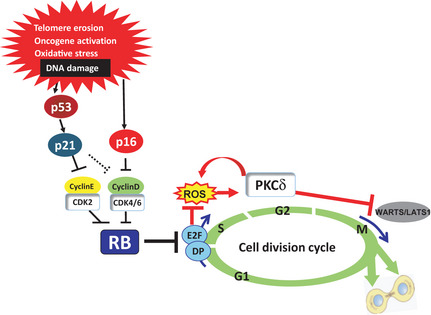Figure 2.

Molecular mechanisms of cellular senescence. A series of cyclin‐dependent kinases (CDK) including CDK2, CDK4 and CDK6 play key roles in regulating the activities of RB‐family proteins. When RB is phosphorylated by these CDK, it loses its ability to bind to and repress the functions of the E2F family of transcription factors, thereby resulting in gene transcription required for the initiation of DNA replication and cell cycle progression. In response to irreparable DNA damage caused by a variety of oncogenic stimuli, expression levels of the p21 Cip1 and p16 Ink4a CDK inhibitors are significantly upregulated by p53‐dependent and p53‐independent mechanisms, respectively. Activation of the p16Ink4a–Rb pathway cooperates with mitogenic signals to induce elevated intracellular levels of reactive oxygen species (ROS), thereby causing activation of PKCδ, a critical downstream mediator of the ROS signaling pathway, and leading to a cytokinetic block that might provide an additional safeguard against the proliferation of senescent cells, especially in the case of RB and p53 subsequently become inactivated.
